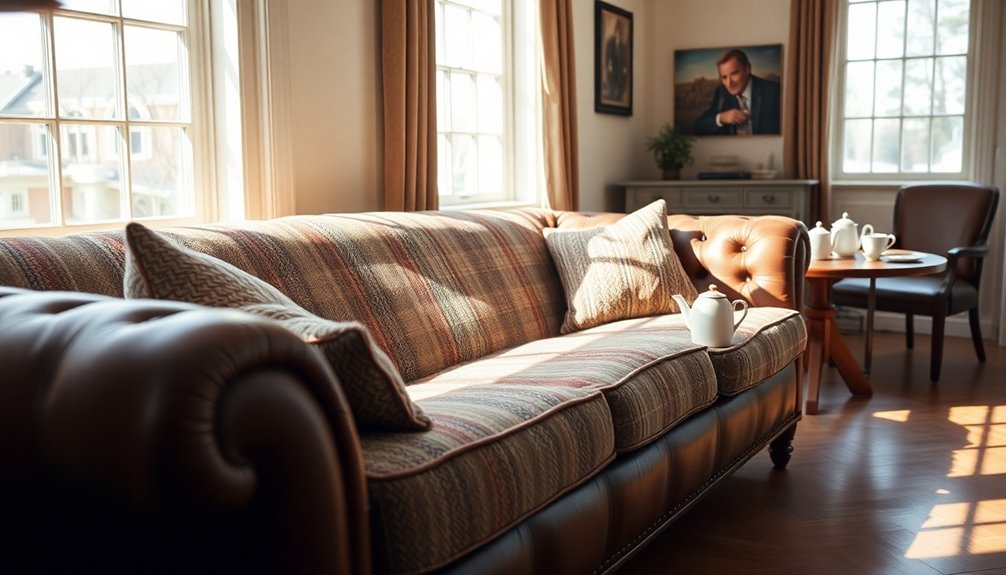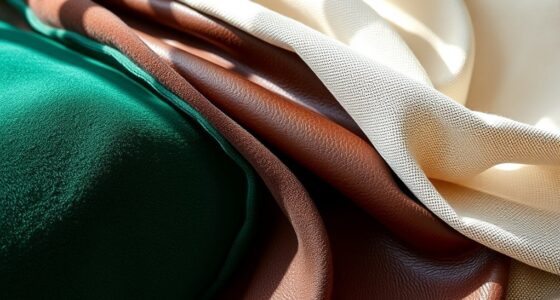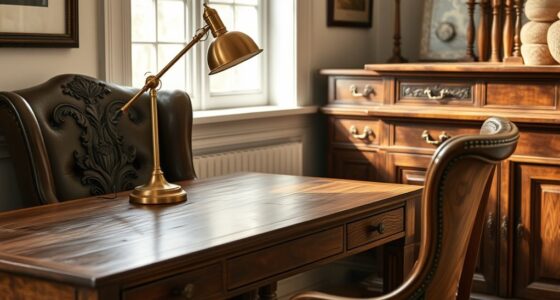The term "sofa" has its origins in Arabic and is mainly used in British English, while "couch" is the preferred term in American English. In the UK, sofas often feature intricate designs and muted colors, fitting the smaller living spaces typical of British homes. In contrast, American couches are typically larger and come in bolder colors, reflecting a more casual use. These differences in terminology and style highlight various cultural influences on furniture. If you're curious about how these terms evolved and their significance, there's plenty more to explore.
Key Takeaways
- The term "sofa" originates from the Arabic word "suffah," while "couch" comes from Old French "couche," meaning "to lay."
- "Sofa" is the preferred term in the UK, whereas "couch" is commonly used in the US.
- In American English, "sofa" carries a formal tone, while "couch" is more casual and relaxed.
- British sofas are designed for smaller spaces, while American sofas accommodate larger layouts.
- Understanding these terms highlights regional differences in furniture design and cultural significance.
Historical Origins of the Sofa
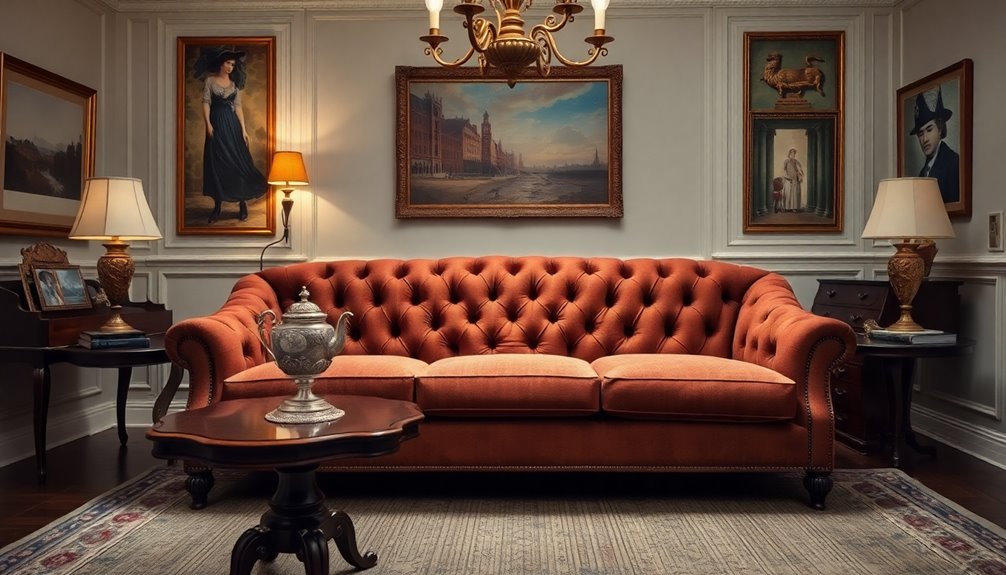
Although you might think of the sofa as a modern comfort, its origins trace back thousands of years to Ancient Egypt, where the concept of a seating structure began.
The term "sofa" comes from the Arabic "suffah," which described a stone or wooden bench used around 2000 BC. Initially, only the wealthy, like Pharaohs, enjoyed luxurious chaise lounges, while plebeians settled for simple stone benches.
After the Roman Empire's fall, sofas became rudimentary benches for almost a millennium. During this time, ornate sofas became symbols of wealth and sophistication in affluent Roman households.
It wasn't until the Industrial Revolution that sofas regained popularity, with advancements in mass production improving comfort and accessibility.
Terminology Differences in English
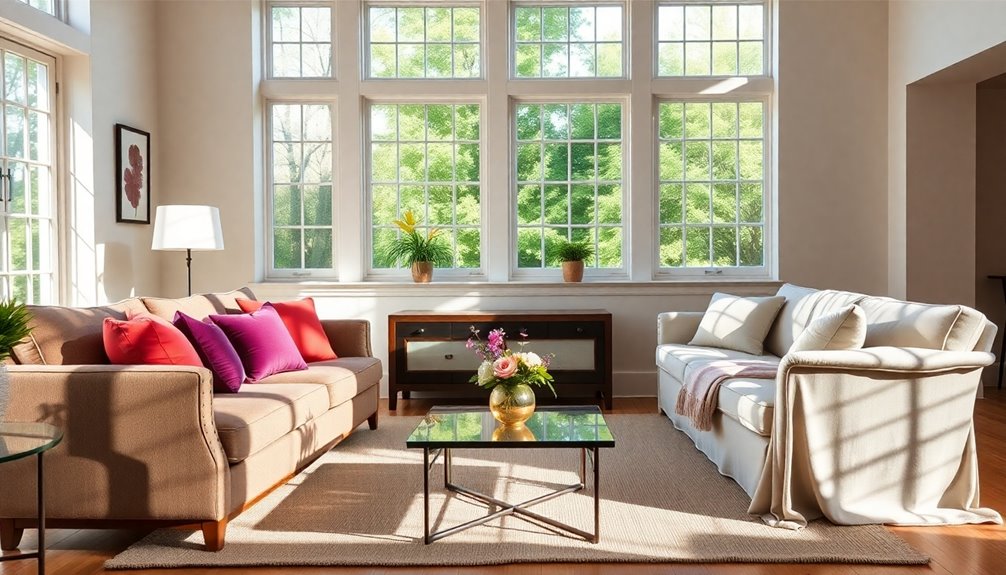
When you talk about seating options, you might notice that "sofa" and "couch" aren't used the same way everywhere.
In the UK, "sofa" is the go-to term, while in the US, "couch" takes the lead in casual conversation.
Understanding these regional vocabulary variations can really enhance your appreciation of furniture terminology. For example, while Americans often refer to a "couch," the term "sofa" is more commonly associated with traditional craftsmanship in British design.
Sofa Vs Couch
Understanding the difference between "sofa" and "couch" can enhance your vocabulary and improve your home decor discussions.
The term "sofa" comes from the Arabic "ṣuffa," while "couch" derives from the Old French "couche," meaning "to lay." In American English, "sofa" tends to carry a more formal tone, whereas "couch" is often used in casual settings. British English prefers "sofa" across contexts. Size also matters: sofas usually seat four or more with prominent backs and armrests, while couches are smaller and often have a more relaxed design. Couches are designed for both sitting and lying down, making them versatile for various activities. Regular cleaning of these pieces of furniture can also enhance indoor air quality by reducing allergens and pollutants.
Both terms can serve as synonyms, but knowing when to use each can add sophistication to your conversations about furniture.
Regional Vocabulary Variations
Language is always evolving, and regional vocabulary variations highlight how terms for everyday items can differ considerably across English-speaking countries.
For instance, if you're in the UK, you'd refer to a baby's sleeping space as a cot, while in the US, it's called a crib. Similarly, what you know as a pushchair in Britain is often called a stroller in America.
When it comes to seating, you might call it a settee in the UK, whereas Americans typically use the term couch. You'll also hear Canadians refer to a couch as a chesterfield. This distinction between terms reflects the cultural preferences of each region regarding furniture terminology. Understanding these variations can also contribute to personal development as it enhances communication and cultural appreciation.
These differences show how cultural influences and historical context shape the vocabulary we use in our daily lives.
Types of Sofas Explained
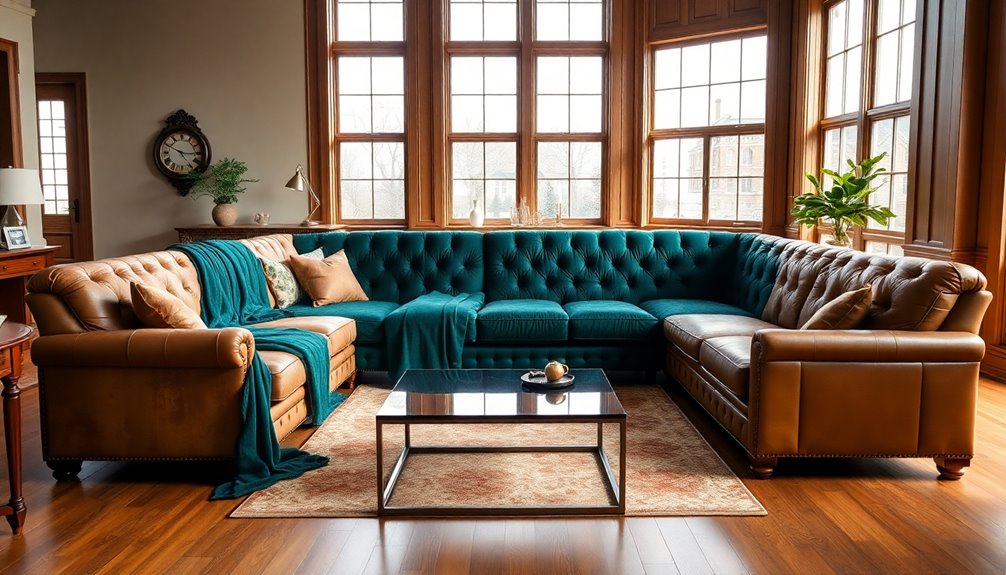
When it comes to selecting the right sofa, you'll encounter a variety of styles, each with unique features. T-cushion sofas offer a distinctive shape that provides extra comfort, while rolled arms add a touch of elegance. If you prefer a clean look, single-cushion seat designs can create a sleek and modern aesthetic in your space. Sofas are often viewed as formal seating options, making them a popular choice for living rooms and lounge areas.
T-Cushion Sofas Overview
T-cushion sofas offer a unique blend of style and comfort that can elevate any living space. With their distinctive T-shaped cushions, they provide both aesthetic appeal and functional support.
Here are some key features to evaluate:
- Shape: T-cushions wrap around the arms, creating a cozy feel.
- Types: You can find full and half T-cushions, offering design versatility.
- Removability: Most T-cushions are removable for easy cleaning and maintenance.
- Style Compatibility: They complement various furniture styles, from contemporary to traditional. Additionally, T-cushion sofas are often categorized as multi-piece slipcovers due to their tailored fit and enhanced appearance.
Whether you're designing a cozy den or a chic living room, T-cushion sofas can enhance your space with comfort and elegance.
Rolled Arm Features
While T-cushion sofas bring a unique charm to your living space, rolled arm sofas offer their own set of appealing features.
With their curved shape and L-shaped profile, rolled arms provide both elegance and comfort. The shorter armrests create a sloping outline, enhancing the sofa's design. Ergonomic curves make lounging or reading a pleasure, while T-shaped cushions give the arms a refined look. The Standard Arm English Sofa design has endured over 150 years, showcasing its timeless appeal.
You'll find various types, like English roll arms for cozy napping, or Basel roll arms for a sleek, professional vibe.
Plus, they come in countless fabrics and leathers, allowing for personal expression. Whether your style is traditional or modern, rolled arm sofas add sophistication to any room.
Single-Cushion Seat Design
Single-cushion seat designs provide a seamless and stylish seating option that enhances both comfort and aesthetics in your living space.
Here are some key features of these sofas:
- Comfort: The single cushion offers a smooth, uninterrupted surface for lounging.
- Versatility: These sofas can easily be paired with throw pillows for added flair.
- Maintenance: Removable cushion covers simplify cleaning and upkeep.
- Durability: Built with solid wood frames and high-resiliency foam, they stand the test of time. Additionally, many models are available in various materials, including fabric and vegan leather, catering to diverse customer preferences.
Whether you opt for a modern design like the Bobbi Sofa or a classic look with the Birch Lane Sofas, single-cushion seats make a striking addition to any room while ensuring comfort and style.
Historical Materials in Sofas

Throughout history, sofas have evolved considerably regarding materials, reflecting the changing tastes and technological advancements of each era. Early sofas featured wood, stone, and horsehair, while the 16th to 18th centuries introduced innovations like dried moss and leather upholstery. By the 18th and 19th centuries, walnut frames and sewing machines revolutionized design. Couches have served as seating for multiple people, which underscores their cultural significance in home environments.
Here's a quick overview of the materials used throughout the ages:
| Era | Key Materials | Notable Innovations |
|---|---|---|
| Early Materials | Wood, Stone, Horsehair | Influence of Arabic "ṣuffa" |
| 16th-18th Century | Dried Moss, Down, Leather | Turkey Work embroidery |
| 18th-19th Century | Foam, Steel Frames | Advent of sewing machines |
| Modern Materials | Plastic, Synthetic Fabrics | Combination padding techniques |
Regional Design Variations
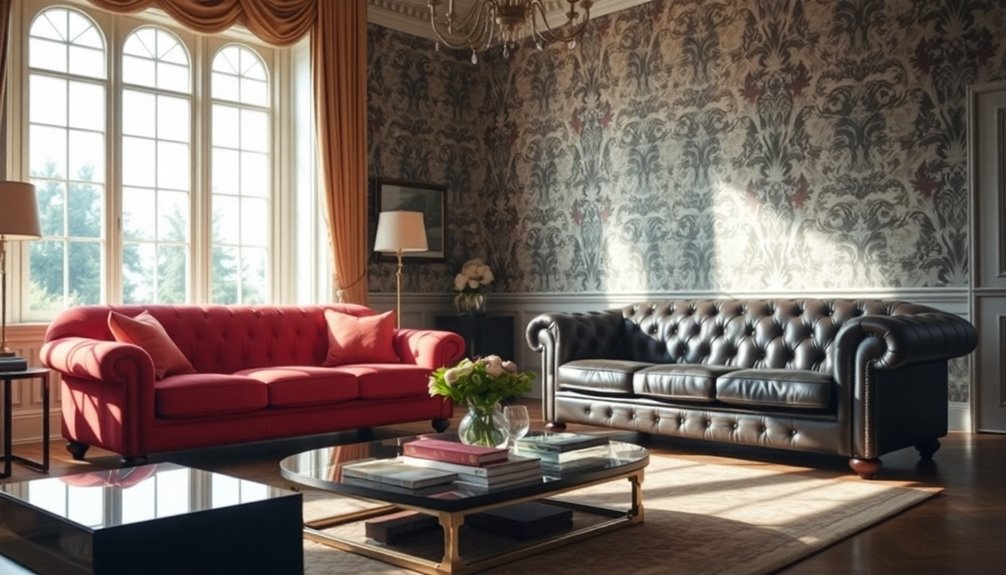
As you explore the world of sofas, you'll quickly notice that regional design variations play a significant role in shaping their aesthetics and functionality.
Understanding these differences can enhance your appreciation for sofa design. Here are some key aspects:
- Size and Proportions: British sofas often fit smaller spaces, while American sofas embrace larger, open layouts. Indonesian decorative pillows, with their vibrant colors, can add a unique cultural touch to both styles.
- Architectural Details: British designs favor intricate, traditional elements, while Americans blend various styles for a more eclectic feel. Traditional sofas emphasize fine craftsmanship and decorative detailing, which is a hallmark of British design.
- Materials and Textures: British sofas use rich fabrics like velvet, whereas American designs often incorporate modern materials like leather and metal. Additionally, Indonesian style home decor often emphasizes the use of natural materials that can complement both British and American furniture.
- Color Schemes: Expect muted, earthy tones in British sofas, contrasting with the bolder, experimental colors of American counterparts. Incorporating Indonesian art decor can enhance these color schemes by adding depth and character.
These variations reflect cultural preferences and practical considerations, making each style unique.
Contemporary Furniture Terminology
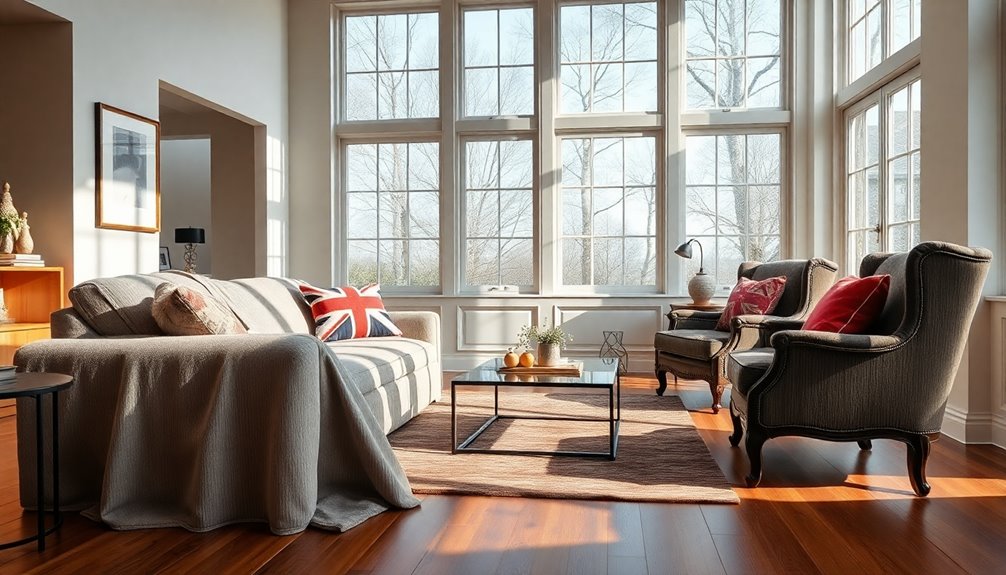
Understanding regional design variations offers valuable insights into the broader context of furniture design, particularly when exploring contemporary terminology.
Contemporary furniture embodies current tastes, featuring clean lines and minimalist aesthetics. You'll notice a preference for neutral tones, often blending traditional and modern elements. Since 2020, this style has evolved to embrace both opposing styles and maximalist motifs.
Expect to see sofas arranged in versatile configurations, such as L-shapes or U-shapes, prioritizing comfort and relaxation. Terms like "sectional," "loveseat," and "shelter" describe specific designs. Additionally, many contemporary pieces utilize high-end materials like leather and techniques like eight-way hand-tied springs. Ultimately, contemporary terminology reflects an ever-evolving dialogue within the furniture design landscape.
Global Influence on Sofa Design
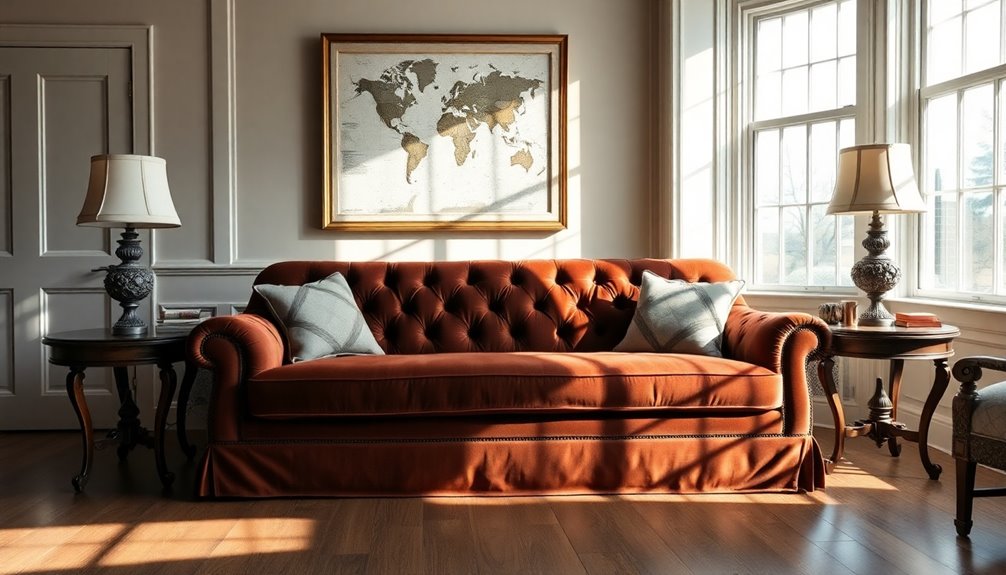
While exploring the global influence on sofa design, you'll uncover how diverse cultural backgrounds shape these essential pieces of furniture. Each region brings its own flair and functionality, making sofas not just practical but also culturally significant.
Consider these influences:
- Eastern Mediterranean: Sofas evolved from Arabic benches to luxurious French designs, emphasizing comfort and elegance. The incorporation of natural materials enhances the authenticity of these designs.
- Western European: High-end materials like velvet and leather dominate, reflecting luxury and modern technology, with Chesterfield sofas being an iconic representation of timeless British design.
- American: Sectional and recliner sofas became symbols of comfort, featuring innovative designs and materials.
- Global Cultures: From Moroccan geometric patterns to Japanese minimalist designs, each culture adds unique character to sofa aesthetics.
In this way, sofas embody a rich tapestry of global influences, weaving together comfort and cultural expression.
Frequently Asked Questions
What Are the Most Popular Sofa Styles Today?
Today, you'll find several popular sofa styles that cater to different tastes.
Modern minimalist sofas feature clean lines and neutral colors, while traditional styles boast timeless elegance with rolled arms and luxurious fabrics.
Curvaceous, cocooning designs offer a soft, inviting feel, and sustainable, maximalist options appeal to eco-conscious consumers with bold patterns and natural materials.
Each style brings its unique charm, allowing you to create a space that reflects your personality and lifestyle.
How Do I Choose the Right Sofa for My Home?
Choosing the right sofa for your home is like finding the perfect puzzle piece—it needs to fit seamlessly into your space.
Start by measuring your room, allowing for movement around the sofa. Think about your lifestyle: will you use it for lounging, or do you need extra storage?
Select a style that complements your decor, and choose materials that suit your needs.
Finally, consider features like USB ports for added convenience and comfort.
What Materials Are Best for Sofa Durability?
When choosing a sofa, opt for durable materials like leather or performance fabrics.
Leather's stain resistance and low maintenance make it a great choice, while performance fabrics withstand heavy use and retain color well.
If you prefer natural fibers, consider wool for its durability and softness.
Synthetic blends offer affordability and versatility, making them suitable for high-traffic areas.
Prioritize materials that balance durability with your lifestyle needs for lasting comfort.
Are There Specific Care Tips for Maintaining a Sofa?
To keep your sofa looking great, you need to vacuum regularly, fluff cushions often, and wipe down surfaces.
You should clean spills immediately, use protective covers, and avoid direct sunlight.
Rotate cushions to prevent sagging and consider professional cleaning for stubborn stains.
Lift your sofa when moving it, and dust wooden frames to maintain their shine.
With consistent care, your sofa will remain stylish and comfortable for years to come.
How Has Sofa Design Evolved in Modern Times?
Sofa design has evolved considerably in modern times.
You'll notice streamlined shapes and innovative materials that prioritize both aesthetics and function. The rise of modular designs gives you flexibility in arranging your space.
Comfort has soared with features like coil springs and cushioned armrests, making relaxation a priority.
Today, you can choose from eco-friendly options and retro-inspired styles, ensuring your sofa not only looks great but also fits your lifestyle perfectly.
Conclusion
So, is the sofa truly American or British? While its roots trace back to the Middle East, evolving through European styles, it's clear that both cultures have made their mark. The term 'sofa' itself might lean toward French origins, but in today's world, it's a global staple. Your choice of sofa reflects not just comfort, but also a blend of histories and designs. So go ahead, embrace your favorite style—it's a reflection of our shared furniture heritage!
